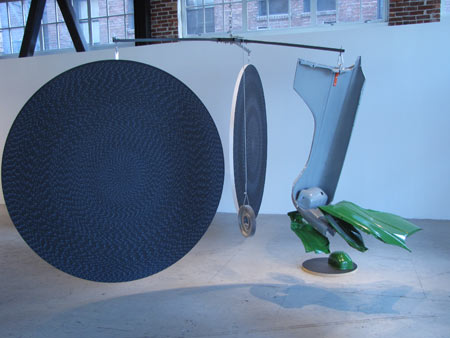
Michelle Grabner and Brad Killam are Chicago-based artists known in left coast parts as the proprietors of an Oak Park, Illinois project space named The Suburban, now celebrating its tenth year (for which they gave a presentation at Southern Exposure’s recent Art Publishing Now symposium). They’re also a couple, showing together here under a provocatively ironic title, “Collaborating with Michelle Grabner Isn’t as much Fun as You Might Think It Is.” So under the media’s current lax rules of critical engagement, they’re fair game for personality journalism of the most egregious type.
That would be true were it not for the fact that the work is compelling. Grabner’s paintings are meticulous and centripetal, pulling you into their ornate, bedewed abstract webs. Killam’s mobiles, casual assemblages of everyday objects painted in bright hues, are spontaneous and expansive, challenging the viewer’s preconceptions about art.
See complete article. . . .
Her mysteriously meditative paintings and drawings, square or circular in format, and generally untitled, are made with flasche paint or silverpoint on dark grounds of black acrylic gesso. Flasche is an opaque, matt-finish, water-based vinyl paint that migrated from animation into the fine-art realm in the 1960s. Silverpoint is the Renaissance precursor to the graphite pencil. Thin rods of silver were used to scratch lines into prepared grounds of organic gesso (animal glues with calcium carbonate). The oxidized marks turned silver-gray. Grabner’s flasche dabs, carefully applied in varying shades, suggest blinking marquee lights, night skies, and variegated animal hides; her silverpoint lines seem more conceptual, whether radiating from a central focus, suggesting polished metal, or evenly dispersed in plaid-like patterns.
Killam’s mobiles are comprised of backyard artifacts in wood, metal and plastic: garbage cans, wheelbarrows, and car fenders that have been flattened and painted with out-of-the-can enamels. These are comic “anxious objects” (to recycle Harold Rosenberg’s 1950s term for artworks pushing aesthetic envelopes and viewers’ buttons) for our do-it-yourself handyman-artist era. One large piece, “Blast Double,” strings various fragments of the good life — the back rest from a lawn chair and a trash can lid are identifiable, though most are not — beneath a small aluminum beam with industrial S-hooks and steel cable. Unlike an Alexander Calder mobile, however, there is no windblown choreography. These pieces hang together, mute and abject but for their shiny paint jobs. A smaller piece, “Huskie Five,” suggests a bird feeder decorated with wired-on tin-snip versions of 1960s Richard Tuttle cloth paintings and ballasted with a “sinker” of oversized washers.
A couple of collaborative pieces, the wall-mounted “Head Gear #1” and the sprawling, room-filling mobile, “Down Block,” which includes two large tondo-format Grabner paintings along with Killam’s orange locker, a metal flywheel, an aqua fender, green metal scraps (one of which rests atop a small Grabner circular-painting “base”) and steel cables, work surprisingly and inexplicably well: better living through chemistry.
